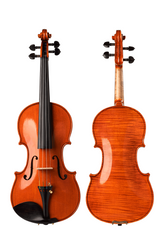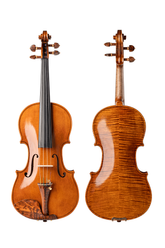Basic knowledge of violin wood 1: the organizational structure of wood
Every time I see those beautifully crafted violins with excellent acoustics, I have to feel that the craftsmanship of the master violin maker is very good. But to make the perfect violin, the choice of wood is the most basic factor. Fiddlover Violin Shop, as a violin shop with 30 years of violin-making craftsmanship, naturally has strict requirements on the selection of wood. So, let's take you to understand the secrets of wood belonging to the violin industry.
People always expect those violins with great sound and beautiful appearance, however, violins are made of wood, and the quality and acoustic properties of wood must have a huge impact on the violin. The ancient luthier masters were very strict in the choice of wood, especially the acoustic properties of the wood. So much so that people still think that the reason why the current violin is inferior to the ancient violin is that there is no good wood (the earth was in the Little Ice Age at that time, and the wood was greatly affected by this). In short, it is better to choose wood with excellent acoustic performance and uniform and stable wood structure. For our manufacturers, the first thing we must understand is the structure of wood. For violin making, it is necessary to have a clear understanding of the growth rings, pith lines, and patterns of the wood.
Annual Rings:
Wood is composed of cells. The cell walls of plant cells are rich in vitamins. There is not only water in the cells but also proteins, carbohydrates, fats, plant alkaloids, and terpenes. There are free water and pectin between cells. In the water, the proportion of free water is about 60%, bound water is 35%, and chemically bound water is 5%. The bark is divided into phloem and cambium. The phloem transports nutrients for photosynthesis, and the cambium makes the tree grow thicker. There are vascular bundles in the center of the trunk, which transport water and fertilizers absorbed from the roots. The top of the trunk has growth tips that allow the tree to grow upwards. On the cross-section of the trunk, you can see that the rings of different colors are the annual rings of the tree. The annual rings grow once a year, and each ring consists of two layers. Springwood and autumn wood are formed due to changes in the tree's growing season or environment.
Spring wood: In the spring and summer of each year, due to the high temperature and large rainfall, the tree grows faster, the formed cell wall is thinner, the wood is loose, the water content is high, the color is lighter, and the tree pattern is wider.
Autumn wood: In autumn and winter, due to a lower temperature and less precipitation, the tree grows slowly, the cells are smaller and the cell wall is thick, the color is darker, the texture is dense and hard, and it appears narrower.
Wood will mutate under the influence of factors such as region, altitude, climate, and environment, and these changes will be reflected in the growth rings, so a discipline called dendrochronology has emerged. This is also what our experienced luthiers must master, and can even obtain accurate information on trees through the analysis of wood growth rings, which is very helpful for us to study antique violins. If you want to buy a precious antique violin, know this and you can better identify the antique violin.
Pith Lines:
The pith line is the nutrient system on the horizontal plane of the tree, also known as the pith bundle, which radiates perpendicularly to the annual rings on the cross-section of the trunk, and is an elongated rectangular ribbon-like stripe. Unpatterned maple wood fibers are straight so that the pith lines are visible in the radial section of the wood, and the specific shape is spotted or bear claw stripes. This unpatterned maple is often used for bridges because of its straight fibers, harder wood, and distinct pith bundles. When the wood is fully diametrically cut, the back of the bridge is parallel to the cut surface so the pith bundle is rectangular, the front side of the bridge is beveled and the pith bundle is cut, so it looks like a spot.
Pattern:
The wood fibers grow in the same direction as the tree, but the patterned maple fibers grow in waves and curls. On the longitudinal section of the trunk, due to the undulation of wood fibers, the absorption and reflection of incident light are different, and the patterns appearing in light and dark or various shapes are called curl patterns or flame patterns, and sometimes form like blisters or the ripples on the surface of the basket.
If the wood is slowly turned, the light and shade of the pattern will change due to the change of the incident and reflection angles of the light, and the color and sound can be seen on the painted violin, which can also assist in identifying the violin pattern are true or false. In pursuit of the beauty of the pattern on the back of the violin, the wood is cut flat-sawn. The wood of the flat sawn has a bird's eye pattern. However, the wood strength of flat sawn is relatively low and requires more attention when making. In the Stradivari era, the wealthy nobles bought violins more for collection, so the violins made for them not only have beautiful acoustics but also the patterns on the back of the violins are very beautiful. It was later thought that a violin with a beautiful pattern was the best choice, both aesthetically and acoustically.
Follow Fiddlover to learn more about the violin.





